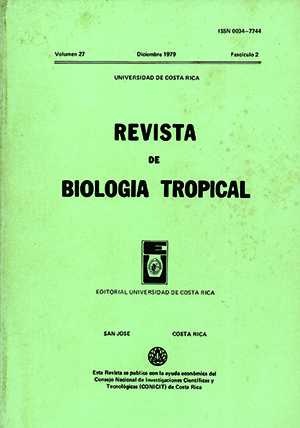Abstract
The frequency of genital Herpes simplex type 2 infections in a group of twenty adult Costa Rican women was studied by isolation of the virus and the measurement of neutralizing antibody activity in sera. The virus could not be isolated in any of the vaginal secretions. Neutralizing antibody activity to herpes virus types 1 and 2 was found in sera from sixteen subjects. An antibody II/I index equal to or larger than 87, indicative of infection with Herpes simplex type 2 was found in fifty per cent of the population studied, a second segment was composed by the subjects with indices below 87. Evaluation of antibody activity to Herpes simplex type 2 revealed that: a) only a small percentage of the women lacked detectable antibody activity to the virus; b) there is a significant difference (p<000.5) between the mean number of years of sexual experience among the two population segments; and c) there is a positive correlation (p<0.05) between II/I index values and age among the women of the population segment with a II/I index equal to or larger than 87.
References
Adam, E., R.H. Kaufman, J.L. Melnick, A.H. Levy, & W.E. Rawls. 1972. Seroepidemiologic studies of Herpesvirus type 2 and carcinoma of the cervix. III. Houston, Texas. Amer. J. Epidemiol., 96: 427-442.
Aurelian, L. 1973. Virions and antigens of Herpes simplex type 2. Symposium: herpesvirus and cervical cancer. Cancer Res., 33: 1539-1547.
Aurelian, L. 1976. Sexually transmitted cancers? The case for genital herpes. J. Amer. Vener. Dis. Ass., 2: 10-20.
Aurelian, L., B.C. Strnad, & M.F. Smith. 1977. Inmunodiagnostic potential of a virus-coded tumor-associated antigen (AG-4) in cervical cancer. Cancer, 39: 1834-1849.
Elstein, M. 1973. The present status o f contraception, p. 298. In E. A. Banner & A.V. Greeley (eds.). The Searle Review of Obstetrics and Gynecology Literature. Science & Medicine Publishing Co., Inc. New York.
Figueroa, M., & W.E. Rawls. 1969. Biological markers for the differentiation of Herpes-virus strains of oral and genital origino J. Gen. Virol., 4: 259-267.
Figueroa, M., & A. Zambrana. 1976. El herpes genital en Honduras y su relación con el carcinoma del cervix uterino. Rev. Lat-amer. Microbiol., 18: 111-116.
Gómez, M., & J.M. Salazar. 1976. Sexto Seminario Nacional de Demografía. Universidad Nacional, Heredia, Costa Rica.
Lyon, F.A. 1975. The development of adenocarcinoma of the endometrium in young women receiving long-term sequential oral contraception. Amer. J. Obstet, Gynec., 123: 299-301.
Martin, C.E. 1967. Epidemiology of cancer of the cervix. Marital and coital factors in cervical cancer. Amer. J. Publ. Hlth., 57: 803-814.
Plummer, G., & J. G. Masterson. 1971. Herpes simplex viru s and cancer of the cervix. Amer. J. Obstet. Gynec., 111: 81-84.
Rawls, W.E., K. lwamoto, E. Adam, & J.L. Melnick. 1970. Measurement of antibodies to Herpesvirus types 1 and 2, in human sera. J. Immunol., 104: 599-606.
Rotkin. L.D. 1967. Epidemiology of cancer of the cervix. Sexual characteristics of a cervical cancer population. Amer. J. Publ. Hlth., 57: 815-829.
Siegel, S. 1975. Estatistica nao-paramétrica para as Ciencias do Comportamento. Traducido al Portuguéz por Alfredo Alves de Faries, McGraW·Hill do Brasil, Ltda. Sao Paulo. 350 p.
Thomas, D.B. 1972. Relationship of oral contraceptives to cervical carcinogenesis. Obstet. Gynec., 40: 508-518.
Towne, J.E. 1955. Carcinoma of the cervix in nulliparous and celibate women. Amer. J. Obstet. Gynec., 69: 606-611.
##plugins.facebook.comentarios##

This work is licensed under a Creative Commons Attribution 4.0 International License.
Copyright (c) 1979 Revista de Biología Tropical


